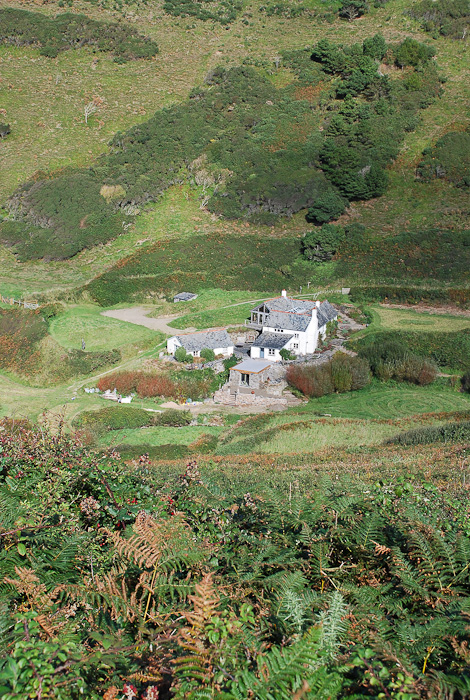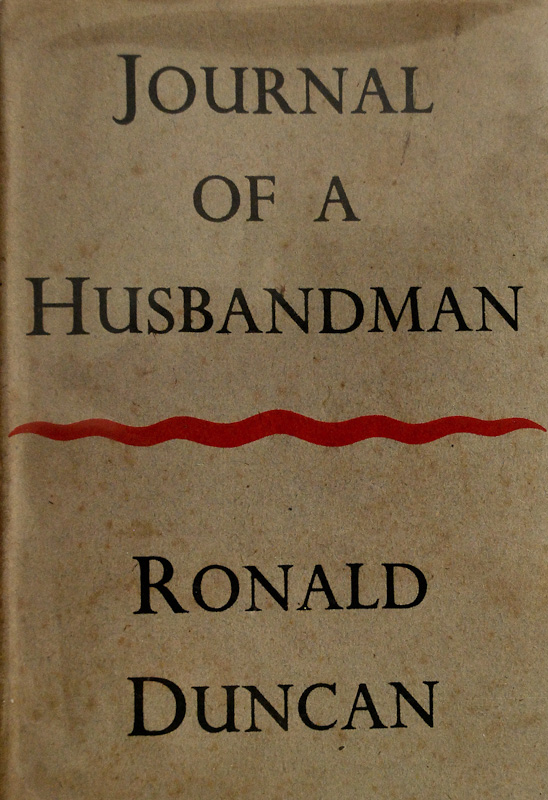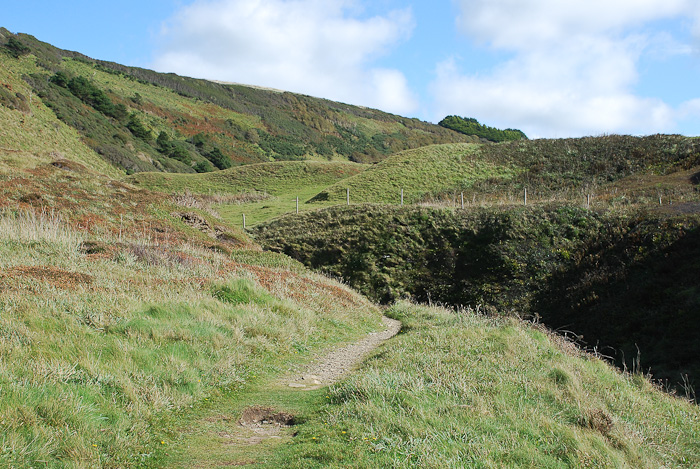After our stay at Morwenstow I wanted to find out more about Ronald Duncan and his connections with West Mill and Welcombe (see my previous post on the Marsland Valley, September 2010). Duncan’s books are out of print but Where I Live, Devon and Cornwall and Journal of a Husbandman were affordable secondhand, and Devon Library Services provided well-worn copies of his three autobiographies, All Men Are Islands, How to Make Enemies, and Obsessed, along with an almost pristine Collected Poems. Duncan was born in 1914 in Zimbabwe and grew up in London. In All Men are Islands he writes:
I was six years old when I first saw the sea and the countryside. My mother took my sister and me for a holiday to Welcombe on the north Devon coast. I fell in love with the place immediately. I decided that was where I wanted to live. I had to wait another twelve years, but I have lived there ever since. (AMAI, p. 35)
It’s an appealing picture, but also a bit misleading – like many people who dream of achieving literary success while living in rural tranquility, Duncan became more and more entangled with London life as the years went by. With the encouragement of Ezra Pound he founded a periodical called The Townsman (although he did change the title later to The Scythe) and his country column for the London Evening Standard, ‘Jan’s Journal’, seems to have been largely fictional. He was a prolific and diverse writer and his published work includes poetry, plays, opera and a film script. In the 1950s he co-founded the English Stage Company and pioneered the re-opening of the Royal Court Theatre, and his guests at West Mill included Benjamin Britten, Peter Pears, Kathleen Ferrier and T. S. Eliot.
But in 1937, when he took on the lease of West Mill, he was full of enthusiasm for his new life in Devon. Journal of a Husbandman first appeared as a series of articles in the New English Weekly, and in it he describes the abandoned fields he discovered while searching for his missing horse, and which he later purchased for a wartime experiment in community living:
My horse was almost hidden by the bracken through which I waded. She was eating gorse. There was no grass. There was bracken, brambles, ragwort, nettles, thistles, and thorn bushes about which bryony climbed. The job was to get out of this wilderness. I led the horse first this way and then that way but could not coax her through the maze. I remembered that my riding whip had a blade inside it and using this I cut my way out. This brought me to a bank and I noticed that the bank was walled. This wilderness was once a field…
As soon as I got on to a track again and had taken my bearings, I realised that the wilderness must be part of the land belonging to a small farm of some thirty or forty acres which had been vacant and derelict for fifteen years. I had visited it twenty years ago as a child to steal apples.
The place is suitable, for it is utterly derelict. We cannot not spoil it: each day’s work will improve, clear and encourage. Whereas if as a novice, I take a farm in good heart, hedged and gated, my inexperience will be expensive in depreciations: we will see the land slide back, not creep forward. And the situation is I think suitable for a social experiment, for it is wholly isolated: the nearest house a mile away. On one side Farracott [Darracott] Hill, up which no average car can climb; on the other side Looseham [Gooseham] Hill, down which no normal driver dare descend. (JOAH, p. 7-8)
Duncan’s descriptions of this oddly-assorted community make interesting reading, and his account of bringing in the harvest in the summer of 1940, a few weeks before the Battle of Britain, conjures up a vivid picture:
By six, one field was in and the weather still held. Tiredness said it would be dry again tomorrow, but Yeoford’s man said it would rain, and so it was decided to carry the other field right away.
Energy is not the same thing as urgency, and it was quite dark before the field was half carried. The last half was lifted into the moon which turned the sheaves silver. As we threw up the last sheaf onto the stack Yeoford’s man caught it and held it up and shouted: “Ah! this be the one we been all day a-looking for!” He had waited all day for the privilege of making that traditional gesture.
Now it was nearly midnight and we were too tired to get any supper. But much more than corn was carried; a dead weight of social frigidity has been lifted. If we could work like this every day, something would get built. (JOAH, p. 53).
The plan of founding “an order based on agriculture” ended in failure, and by 1943 Duncan and his family were alone again and he was “farming with one hand and writing with the other”. Sadly, his farsighted attempt in the 1970s to achieve an increase in the number of hardwood trees being planted in England also went awry, and resulted in five acres of Forestry Commission Sitka Spruce on the slope of the Marsland Valley.
A century before Ronald Duncan’s arrival at West Mill another writer made his home a few miles away. Robert Stephen Hawker came to Morwenstow as vicar in 1835, and for forty years he too combined farming with writing poetry and maintaining a substantial and lively correspondence. Like Duncan he had known the area since childhood, and his best work draws on his love for the wild coast and the customs of the countryside. Duncan was well aware of his predecessor and there are several references to him in Devon and Cornwall, but it was a particular pleasure to find Hawker and his pig, Gyp, mentioned, along with Gandhi, as an inspiration for the character of St Anthony in his first play, This Way to the Tomb.
The Marsland valley remains a beautiful and largely unspoiled place, but farming has changed so radically that much of the appeal of Journal of a Husbandman and Where I Live is that of messages from a vanished world. A good deal of the work in the Collected Poems is obsessively autobiographical and self-conscious, and I often felt excluded and uninvolved as a reader – the verses in This Way to the Tomb seem more effective than many of the ones in the book. But in reading the best of them the gap of years vanishes and the voice of the poet is close and accessible.
Ronald Duncan died in 1982, aged 68, but West Mill still belongs to his family, and his cliff-top hut – another echo of Hawker – continues to provide shelter for walkers on the coast path. It would be good to see some of his work back in print.
SELECTED WORKS BY RONALD DUNCAN
Collected Poems, edited by Miranda Weston-Smith.Heineman/Quixote Press, 1981.
Journal of a Husbandman. Faber and Faber, 1944.
Where I Live. Museum Press, 1953.
All Men Are Islands. Rupert Hart-Davis, 1964.
* * * * *
Quotations from Journal of a Husbandman and All Men Are Islands by Ronald Duncan © The Ronald Duncan Literary Foundation
Other text and photos © Angela Williams 2010 – 2011
LINKS
– Ronald Duncan’s writing hut at West Mill
– The Ronald Duncan Literary Foundation
– Some Landscapes: Ronald Duncan’s album ‘The Seasons’




Comments
One response to “Ronald Duncan at West Mill”
In 1943 I was a young physicist learning about radar and working at an RAF research station which then occupied the buildings at Great Malvern of Malvern College. I was fascinated by Duncan’s great poem “Man”. I remember reading about it, that he had broken off all his other work for two years in order to to teach himself enough about the present state of Science – Quantum Mechanics, and all the rest of the modern story. I went to great lengths to acquire all parts of this poem, and I’m sure that I have parts of it still, somewhere here in my house in Sutton Courtenay near Oxford. I’ll search for these parts. I ask anyone who still has any bits of this poem to get in touch with me by email (I hope you’ll publish my email address).
The part of “Man” that I know I still have (if only I could find it) cover Duncan’s imagined primitive man struggling to produce sounds that would mean something to his comrades. His treatment of this was utterly convincing. I take this to be a successful pioneering effort, to understand the message of modern science and to present it, passionately, through the modern poetic medium. Well done, Ronald !
There is growing interest in linking Religion and Science – at least, to mark out and compare their separate fields. Duncan made a big contribution towards this, but that is hardly mentioned in the texts about him that I’ve seen, in Wiki for example. Please, let’s have some discussion about his great poem “Man”. And let’s get it into circulation somehow, if only as scans which could then be circulated on the Web . . . .
Chris Taylor 15 August 2012